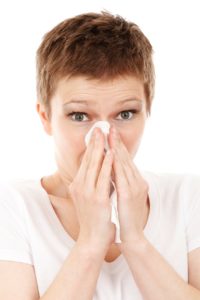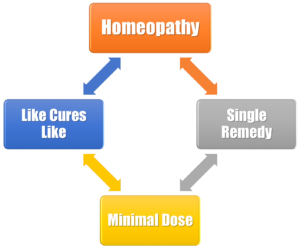8 Ways To Relieve Seasonal Allergy Symptoms Without OTC Antihistamines
 Anyone who suffers the symptoms of itchy eyes, sneezing, runny nose, hives, etc., from seasonal or pet allergies knows how miserable it can be. The big culprit for me is sumac pollen, what many people commonly refer to as the Tree of Heaven I call the Tree of H*!!, and they’re everywhere in my neighborhood because they grow like weeds, and once established they’re almost impossible to get rid of. Starting about mid-June everything is covered in yellow pollen from these trees, and I start feeling my throat start itching within a few blocks of these trees for about a month and a half.
Anyone who suffers the symptoms of itchy eyes, sneezing, runny nose, hives, etc., from seasonal or pet allergies knows how miserable it can be. The big culprit for me is sumac pollen, what many people commonly refer to as the Tree of Heaven I call the Tree of H*!!, and they’re everywhere in my neighborhood because they grow like weeds, and once established they’re almost impossible to get rid of. Starting about mid-June everything is covered in yellow pollen from these trees, and I start feeling my throat start itching within a few blocks of these trees for about a month and a half.
Allergies are caused by your immune system overreacting to a foreign substance, like the proteins found in pollen, pet dander, and foods. The histamine produced causes inflammation in our bodies, which cause the symptoms we experience.
It hit me when I turned 40, until then I never had allergies. I thought it was a weird cold that wasn’t going away until someone told me what it was. It took me a couple years after that to make the connection to the tree. It’s one of my favorite times of the year, long daylight hours, when I should be out working in the yard and enjoying the weather, but it forces me to confinement in the house, which helps only a little.
What Works Best
Of course, the best option is to not allow the problem-causing substance in or on our bodies. Unfortunately, moving somewhere else for six weeks, or cutting down all the sumacs in Yakima are not options. When I do have to go outside (to pick the raspberries, feed the chickens, water the greenhouse) I have found wearing a pollen mask helps. I also wear it at night, at least until I pull it off in my sleep, or any time during the day when I feel I need a little extra protection.
I’ve tried every OTC antihistamine on the market, which only made me feel tired and my mouth dry, but did little for controlling the other symptoms.
 A life saver for me is a homeopathic formula called Bioallers Tree Pollen. As long as I remember to take this every 3-4 hours I am almost symptom-free…trust me, I don’t need a clock to remind me, when I start feeling that itch at the back of my throat I know it’s time. There’s no dry-mouth, tiredness, or any other side-effects that come with taking the OTC antihistamines, either.
A life saver for me is a homeopathic formula called Bioallers Tree Pollen. As long as I remember to take this every 3-4 hours I am almost symptom-free…trust me, I don’t need a clock to remind me, when I start feeling that itch at the back of my throat I know it’s time. There’s no dry-mouth, tiredness, or any other side-effects that come with taking the OTC antihistamines, either.
For itchy, red eyes usually all I need to do is apply a drop of lavender essential oil to my temples and it stops the itch. Lavender has antihistamine properties. For the times when I need a little extra eye itch relief I use ketotifen fumarate antihistamine eye drops, like Zadiator, or a generic brand, which is a little less expensive. It works very well for me.
One more thing that seemed to make a huge difference last year is CBD oil. I had started taking hemp CBD oil supplements about a month before allergy season started, and as far as allergy seasons go, it was by far the most mild. CBD oil has amazing anti-inflammatory properties. However, all CBD oil is not equal, so don’t rush down to the local dispensary and get some before knowing what to look for, click here to see what to look for first.
Other Things I Do That Help
On their own, I’ve tried the following options with little relief, but when combined with the above options, they work together with noticeable improvements.
I use a TheraPure air filter in my bedroom, which would help more if we didn’t open the windows and put fans in them to cool the house down at night. But I don’t have central a/c in our house, and, of course, the tree blooms right when when the weather starts getting really warm. This air filter also has a fancy uv light to kill airborne bacteria and viruses, and a photo catalyst filter to reduce toxic fumes and chemicals. 😉
I use a combination of lavender, lemon, and peppermint essential oils. While these oils are enough for some people, this alone does not offer as much relief for me as I needed, but it does help when combined with other options. I apply all three to the bottoms of my feet. I diffuse lavender and peppermint (safe to use around the dogs). I apply the lavender and/or peppermint to my sinuses, temples, and back of my neck. Lavender acts as an antihistamine and calms irritation. Lemon decongests and reduces mucus. Peppermint clears airways and reduces inflammation. Because everybody is different, what works for some may not work for all. Other oils that can be used are basil, rosemary, roman chamomile, myrrh, melaleuca, or cilantro.
I also try to eat less inflammation-causing foods like sugar, gluten, dairy, junkfood….keyword there is TRY. When I’m bad, I pay for it, but it doesn’t always stop me, I’m only human. I don’t drink coffee, but I do love starting my morning with Pollen Burst, a healthy energy drink which contains SOD (superoxide dismutase), a super-powered antioxidant (antioxidants reduce inflammation), and I make sure to take my plant-derived minerals.
And last, but not least, is Quercetin, which has powerful antioxidant, anti-inflammatory, and antihistamine properties, as well as many other benefits. It helps block the release of many inflammatory cytokines. (1) I take a supplement with resveratrol, turmeric, and quercetin during allergy season, and I like to have a bottle of it on hand during flu season as well. It’s called CellShield RTQ. See 7 Proven Benefits of Quercetin, and the Top Natural Sources of Quercetin
[amazon_link asins=’B009R9OL1E,B0086092HS,B00B618T1Y,B014S7O6S2,B006UWMFU0,B001E0SOLM,B002LM3KOI,B00FMUI8CU,B005P0L1LC,B001E0XX9K’ template=’ProductGrid’ store=’ds’ marketplace=’US’ link_id=’47672922-1a57-11e8-97f2-df16584a5600′]
